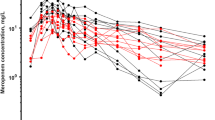Summary
Guidelines presented previously for the analysis of plasma concentration versus time data for a drug exhibiting concentration-dependent plasma protein binding were successfully applied to the distributional parameters of a new cephalosporin, ceftriaxone. This approach provided several striking observations when the pharmacokinetics of ceftriaxone in a healthy and uremic population were re-examined. First, the parameter\(\bar f_P \) converted the apparent dose-dependent distributional terms of ceftriaxone into a function of the concentration-dependent plasma protein binding. Second, a strong correlation between the term V USS and the reciprocal of\(\bar f_P \) was established within each of the two populations. While this\(\bar f_P \) term accounted for the variability within the respective populations due to ceftriaxone-albumin binding differences, it did not account for all of the distributional differences between the two populations. The present analysis revealed that the altered physiologic state of uremia (larger plasma volumes and interstitial to intravascular albumin ratios), in addition to differences in plasma protein binding, dictated the distribution of ceftriaxone in healthy and uremic subjects. Furthermore, the binding-disposition model which accounts for the presence of plasma proteins outside the vascular space, was established to be appropriate in describing the distribution of ceftriaxone.
Similar content being viewed by others
References
Stoeckel K, McNamara PJ, Brandt R, Plozza-Nottebrock H, Ziegler WH (1981) Effects of concentration-dependent plasma protein binding on ceftriaxone kinetics. Clin Pharmacol Ther 29: 650–657
McNamara PJ, Stoeckel K, Ziegler WH (1981) Pharmacokinetics of ceftriaxone following the administration of a 3-gram intravenous dose. Eur J Clin Pharmacol 22: 71–75
Stoeckel K, McNamara PJ, Hoppe-Seyler G, Blumberg A, Keller E (1983) Single-dose of ceftriaxone kinetics in functionally anephric patients. Clin Pharmacol Ther 33: 633–641
McNamara PJ, Gibaldi M, Stoeckel K (1983) I. Volume of distribution terms for a drug (ceftriaxone) exhibiting concentration-dependent protein binding. II. Theoretical considerations. Eur J Clin Pharmacol 25: 399–405
Gillette JR (1971) Factors affecting drug metabolism. Ann NY Acad Sci 179: 43–66
Gibaldi M, McNamara PJ (1978) Apparent volumes of distribution and drug binding to plasma proteins and tissues, Eur J Clin Pharmacol 13: 373–378
McNamara PJ, Levy G, Gibaldi M (1979) Effect of plasma protein and tissue binding on the time course of drug concentration in plasma. J Pharmacokinet Biopharm 7: 195–206
McNamara PJ, Slattery JT, Levy G, Gibaldi M (1979) Accumulation kinetics of drugs with nonlinear plasma protein and tissue binding characteristics. J Pharmacokinet Biopharm 7: 397–405
Øie S, Tozer TN (1979) Effect of altered plasma protein binding on apparent volume of distribution. J Pharm Sci 68: 1203–1205
Øie S, Guentert TW, Tozer TN (1980) Effect of saturable binding on the pharmacokinetics of drugs: A simulation. J Pharm Pharmacol 32: 471–477
Trautman KH, Haefelfinger P (1981) Determination of Ro 13-9904 in plasma, urine and bile by means of ion-pair reversed phase chromatography. J High Resol Chromatogr Commun 4: 54–59
Oppenheimer JH, Schwartz JL, Surks MI (1975) Determination of common parameters of iodothyronine metabolism and distribution in man by noncompartmental analysis. J Clin Endocrinol Metab 41: 319–324
Benet LZ, Galeazzi RL (1979) Noncompartmental determination of the steady-state volume of distribution. J Pharm Sci 68: 1071–1074
Craig WA, Evenson MA, Sarver KP, Wagnild JP (1976) Correction of protein-binding defect in uremic sera by charcoal treatment. J Lab Clin Med 87: 637–647
McNamara PJ, Gibaldi M, Stoeckel K (1983) Fraction unbound in interstitial fluid. J Pharm Sci 72: 834–836
Moore FD (1963) The body cell mass and its supporting environment, body composition in health and disease. WB Saunders, Philadelphia, pp 58–101
Cangiano JL, Ramirez-Muxo O, Trevino R, Campos JA (1976) Normal renin uremic hypertension, study of cardiac hemodynamics, plasma volume, extracellular fluid volume and the renin angiotension system. Arch Intern Med 136: 17–23
Bauer JH, Brooks CS (1981) Body fluid composition in chronic renal failure. Clin Nephrol 16: 114–118
Jensen H, Rossing N, Anderson SB, Jarum S (1967) Albumin metabolism in the nephrotic syndrome in adults. Clin Sci 33: 445–457
Johansson SV, Odar-Cederlöf I, Platin L-O, Strandberg PO (1977) Albumin metabolism and gastrointestinal loss of protein in chronic renal failure. Acta Med Scand 201: 353–358
Riggs DS, Guarnieri JA, Adderlman S (1978) Fitting straight lines when both variables are subject to error. Life Sci 22: 1305–1360
Author information
Authors and Affiliations
Rights and permissions
About this article
Cite this article
McNamara, P.J., Gibaldi, M. & Stoeckel, K. Volume of distribution terms for a drug (ceftriaxone) exhibiting concentration-dependent protein binding II. Physiological significance. Eur J Clin Pharmacol 25, 407–412 (1983). https://doi.org/10.1007/BF01037956
Received:
Accepted:
Issue Date:
DOI: https://doi.org/10.1007/BF01037956




